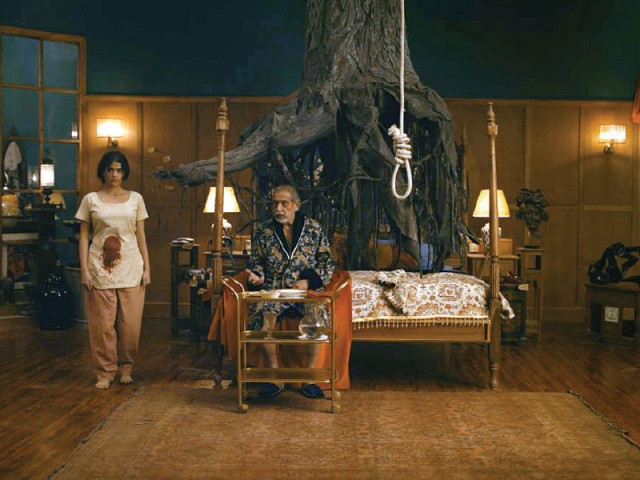Highway to hell
Rich people suffer in ‘Barzakh’ as Asim Abbasi series kicks off

In Asim Abbasi’s latest OTT release Barzakh, the first episode of which premiered on Friday, Salman Shahid plays the well-heeled Jafar Khanzada, all set to marry the ghost of his dead lover, Mahtab (Anika Zulfikar). To mark the occasion, he summons his two sons, Shehryar (Fawad Khan) and Saifullah (Fawad M Khan), while Sanam Saeed plays the enigmatic Scheherezade, caretaker-slash-daughter figure to Jafar.
Bathed in a warm, misty teal and orange palette, cinematographer Mo Azmi’s atmospheric work brings to life a perpetual melancholy. More than eerie, the unnatural union between man and a ghost is a well-crafted reminder of the delicate intimacy of ghost films.
Together with Azmi, Abbasi turns the lavish Hunza Valley setting, replete with rich, fiery foliage of fall into his most autonomous work yet. Even those who are hard to impress can approve of Cake and Churails’ visual style, peppered with plenty of famous shot recreations for cinephiles to spot. If Abbasi’s style in both his last two offerings was conceived of as a film lover himself, with Barzakh the filmmaker is finally building his own vocabulary.
Perhaps, this is why, even as the quiet town where Jafar has erected his resplendent tourist spot protests his growing eccentricities, Barzakh feels far from “unnatural”. In contrast to the poor and disenfranchised in Abbasi’s previous stories, who frequently forge unnatural unions with those in power. Be it his 2018 debut feature film, Cake, which spins a lighthearted drama out of a Christian nurse’s generous sacrifice for a feudal family. Or the elite women of Churails who forget their high society protocols and find sisters in their househelp.
Cinema of the rich?
For a man whose cinematic universe centres the rich in dramatic proximity to the poor, Abbasi is one of the few directors to reproduce the signature Pakistani trope in contemporary local scene. Granted, Abbasi’s wealthy characters do not indulge in insipid platitudes, nor do the poor in his world bear the burden of moral rectitude. Sheer class disparity, made all the more vulgar, is, however, a page taken directly from Pakistan’s screen history.
The small screen too has vowed to execute half of its storytelling between the seth sahab ka larka and mazdoor paisha walid sahib ki larki, swapping the roles at its most daring. Much is there to lament about TV’s malnourished production design, the sad monotony of sets only one failing. Often it seems that the much beloved industry has three houses in rotation to mark the socioeconomic particularities of a manager, a driver and a rags-to-riches turned businessman.
There are many ways to disparage the impoverished worldbuilding of Pakistani television but finding the echoes of previous cine hits in it is at worst descriptive. Class on screen has not come without the baggage of moral qualifiers. In 1971’s Tehzeeb, a wealthy compunctious Shahid, laments with Laga Hai Husn Ka Bazaar as he watches his wife, a village-bred Rani, succumb to modernity’s pleasures. The writing is on the wall for those willing to see.
Five years later, Waheed Murad will don a thick shawl in his mansion in Zubaida and reprise the role of the living room patriarch. The one who sermonises both the deviant woman, Babra Shariff in this case, and the cinemagoer about the conduct of respectable families. A message that was regarded with its due gravity.
Rich in theme and aesthetic
Abbasi’s world is rarely sanctimonious in the manner of 1970’s and 80’s cinema but his portrayal of class is always the main spectacle. It is accurate to say that the filmmaker “reproduces” these socioeconomic anxieties unlike television that has taken to “regurgitating” the obsolete high of virtue signalling.
Call it the death of media literacy at the hands of digital inrush, the cinema of escapism has been dislodged by a politics of relatability. Until my childhood, for Karan Johar to land Rahul’s helicopter in the palatial Raichand estate was both fantastical and taken for granted.
The grandeur of K3G now feels exaggerated. Times and sentiments have changed. Bong Joon-ho’s 2019 drama Parasite is one of the more popular lucid insertions in this cinema of the commoner. And make no mistake. The commoner is now more in vogue than ever. Not that Abbasi seems to care.
It is not that a story about the excesses of the upper class is by default a boring topic. From Luis Buñuel’s The Exterminating Angel to Govind Nihalani’s Party, arthouse cinema has produced many successful polemics against the intellectual and economic elites. Far less frequently does one see the spectacle of wealth characterise a whole emerging body of work.



















COMMENTS
Comments are moderated and generally will be posted if they are on-topic and not abusive.
For more information, please see our Comments FAQ